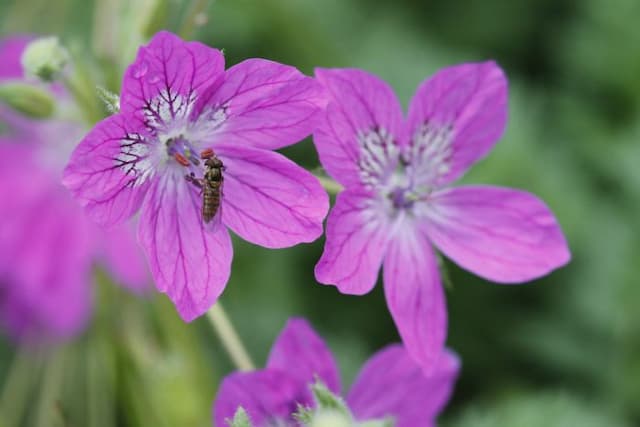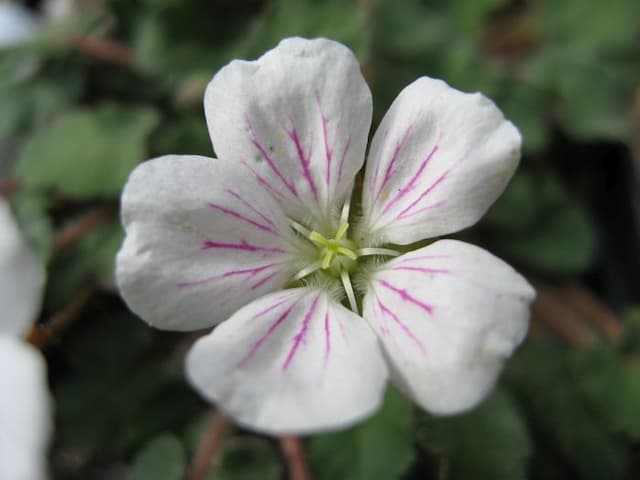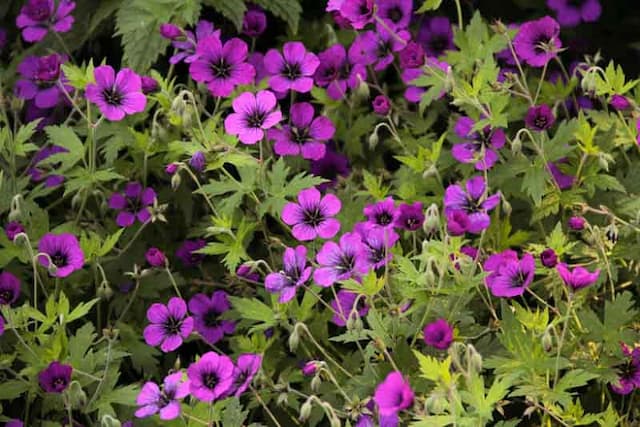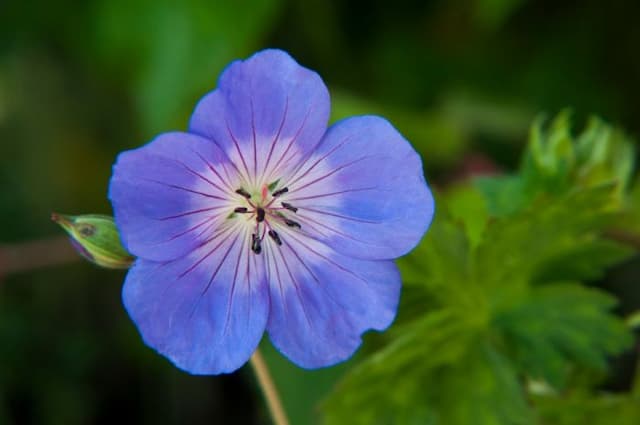Scented Geranium Pelargonium 'Roller's Shadow' (A)

ABOUT
Pelargonium 'Roller's Shadow', commonly known as geranium, is a striking plant known for its ornamental value. The geranium typically has a robust and bushy appearance, with dense foliage that creates an attractive backdrop for its flowers. The leaves are broadly shaped, often displaying a zonal pattern in the heart of the leaf, which can range in color from light green to a deep, almost burgundy shade. The flowers of the 'Roller's Shadow' geranium are particularly eye-catching, usually blooming in clusters atop sturdy stems that rise above the foliage. The flower petals can vary in color, often featuring shades of pinks, reds, or purples, with some having unique color patterns or veining that adds to the plant's aesthetic appeal. The flowers are composed of several petals that come together to form a rounded shape, and they can have a somewhat ruffled look, giving each bloom a full and lush appearance. Overall, the geranium 'Roller's Shadow' is a beautiful and colorful plant that adds a vibrant splash of color wherever it is grown, with its showy flowers and attractive foliage creating a picturesque display.
About this plant
 Names
NamesFamily
Geraniaceae.
Synonyms
Scented Geranium, Storksbill, Roller's Shadow Geranium.
Common names
Pelargonium 'Roller's Shadow'
 Toxicity
ToxicityTo humans
Geraniums, such as Pelargonium 'Roller's Shadow', are generally considered non-toxic to humans. Ingesting parts of this plant might occasionally result in mild gastrointestinal upset, but serious poisoning is unlikely.
To pets
Geraniums are toxic to pets such as dogs and cats. If a pet ingests part of a geranium, it could experience symptoms such as vomiting, anorexia, depression, and dermatitis. In severe cases, it might lead to hypotension and even collapse, but these are not common. Consulting with a veterinarian is recommended if a pet ingests this plant.
 Characteristics
CharacteristicsLife cycle
Perennials
Foliage type
Evergreen
Color of leaves
Green
Flower color
Pink
Height
1-2 feet (30-60 cm)
Spread
1-2 feet (30-60 cm)
Plant type
Herb
Hardiness zones
10
Native area
South Africa
Benefits
 General Benefits
General Benefits- Easy to Grow - Pelargonium 'Roller's Shadow' is relatively low maintenance and grows well in various conditions, making it ideal for novice gardeners.
- Drought Tolerant - Once established, it can withstand dry periods, requiring less frequent watering than many other plants.
- Long Blooming Season - With proper care, it can provide colorful blooms for extended periods, often from spring through fall.
- Aesthetic Appeal - Its attractive foliage and flowers can enhance the beauty of gardens, patios, and indoor spaces.
- Attracts Pollinators - The blooms can attract beneficial insects such as bees and butterflies, supporting local ecosystems.
- Versatile - Suitable for container gardening, borders, and can also be grown as a houseplant, offering flexibility in its use.
- Deer Resistant - Typically not favored by deer, which can be advantageous in gardens susceptible to wildlife grazing.
- Color Variety - Comes in various colors, allowing for a diverse and vibrant garden design.
 Medical Properties
Medical PropertiesThis plant is not used for medical purposes.
 Air-purifying Qualities
Air-purifying QualitiesThis plant is not specifically known for air purifying qualities.
 Other Uses
Other Uses- As a natural dye – The blossoms and leaves of the Pelargonium can be used to create natural dyes for fabric, providing a range of colors from greens to browns depending on the mordant used.
- In aromatherapy – The plant's essential oil is sometimes used in aromatherapy for its calming and relaxing fragrance.
- As a flavoring agent – The leaves can be used to infuse sugars or salts with its subtly rose-scented aroma, which can then be used in cooking and baking.
- For educational purposes – Botany students may study Pelargoniums to learn about leaf morphology, plant physiology, and taxonomy.
- In artwork – Dried leaves and petals can be integrated into paper making or used in potpourri for adding texture and color to visual art projects.
- As a companion plant – In the garden, it may be used to repel certain pests from more sensitive plants due to its aromatic leaves.
- For crafts – The leaves and flowers can be used in crafting, such as making bookmarks, natural jewelry, or pressed flower arrangements.
- In photography – Pelargoniums provide an attractive subject or backdrop for photographers looking to capture their vivid colors and interesting leaf patterns.
- In culinary presentations – Edible varieties can be used as an attractive garnish on plates or to add a splash of color to salads.
- As a teaching tool – For children's gardens or educational workshops, cultivating Pelargoniums can teach about plant care and gardening basics.
Interesting Facts
 Feng Shui
Feng ShuiThe Geranium is not used in Feng Shui practice.
 Zodiac Sign Compitability
Zodiac Sign CompitabilityThe Geranium is not used in astrology practice.
 Plant Symbolism
Plant Symbolism- Comfort: Geraniums, in general, are often associated with comfort due to their lush foliage and vibrant flowers, bringing a sense of well-being to many gardens.
- Friendship: The geranium is sometimes given as a token of esteem and friendship, representing the bonds we share with friends.
- Health: With their bright blooms and ease of growth, geraniums symbolize good health and the maintenance of it, often planted in hospital gardens for this reason.
- Positive Energy: The geranium is believed to promote positive energy and to repel negative energies, making it a popular plant in homes and spiritual practices.
- Longevity: Due to the robust nature of geraniums, they can symbolize longevity and perseverance.
 Water
WaterThe common name for Pelargonium 'Roller's Shadow' is Scented Geranium, and they prefer their soil to be kept evenly moist during the growing season. It's best to water these plants deeply once the top inch of soil feels dry to the touch; this usually ends up being about once a week, but this can vary depending on the environment and pot size. An average amount could be approximately 8-16 ounces of water for smaller pots, or up to 1-2 gallons for larger containers, every week or as needed. Avoid overhead watering to prevent leaf and flower diseases, and ensure that pots have sufficient drainage to prevent waterlogging.
 Light
LightScented Geraniums thrive in bright, indirect light. A spot that receives morning sun and afternoon shade is ideal, as intense afternoon sun can scorch the leaves. If growing indoors, they do well in east or west-facing windows. These plants can also adapt to partial shade conditions but may produce fewer blooms.
 Temperature
TemperatureScented Geraniums prefer a temperature range between 55°F and 70°F. They can tolerate minimum temperatures down to about 30°F, but they are not frost-hardy and should be protected or brought indoors when cold weather is imminent. Optimal growth occurs within the preferred temperature range; extreme heat or cold can stress the plant.
 Pruning
PruningPruning Scented Geraniums encourages bushier growth and prevents them from getting leggy. It is best to prune them in early spring or just after they start to put out new growth. You can prune them lightly throughout the year to maintain shape and encourage new foliage. Prune by snipping off overgrown stems and removing any dead or yellowing leaves.
 Cleaning
CleaningAs needed
 Soil
SoilThe best soil mix for a Scented Geranium (most common name for Pelargonium 'Roller's Shadow') is light, well-draining potting soil with added perlite or coarse sand. It should have a slightly acidic to neutral pH, around 6.0 to 7.0.
 Repotting
RepottingScented Geraniums should be repotted every 1 to 2 years, typically in spring before the onset of active growth.
 Humidity & Misting
Humidity & MistingScented Geraniums prefer moderate humidity levels, around 40-50%, avoiding overly humid conditions.
 Suitable locations
Suitable locationsIndoor
Place in bright indirect light, avoid overwatering.
Outdoor
Provide sun to partial shade, protect from strong winds.
Hardiness zone
9-11 USDA
 Life cycle
Life cycleThe life cycle of Pelargonium 'Roller's Shadow', commonly known as Geranium, begins with seed germination, where proper soil, warmth, and moisture will lead to the emergence of seedlings. After germination, the plant enters the vegetative stage characterized by leaf growth and the development of a strong root system. As the Geranium matures, it reaches the flowering stage, producing distinctive blooms that range in color depending on the variety. Following pollination, the plant may produce seeds, allowing for the potential spread of offspring, but it can also be propagated via cuttings. Geraniums are perennial in warmer climates, meaning they can live for several years, while in cooler regions, they are often treated as annuals and will require replanting each year. If environmental conditions are favorable, Geranium 'Roller's Shadow' will repeat this cycle, continuing to grow, flower, and potentially produce seeds or be propagated through cuttings season after season.
 Propogation
PropogationPropogation time
Spring-Early Summer
Propogation: Pelargonium 'Roller's Shadow', commonly referred to as Rose-scented Geranium, is most effectively propagated through stem cuttings. The best time for propagation is spring or early summer when the plant is actively growing. To propagate, a healthy stem of about 4 to 6 inches (10 to 15 centimeters) long is cut from the parent plant. The cutting should have several sets of leaves. The lower leaves are removed, and the cut end is dipped in rooting hormone to encourage root growth. The prepared cutting is then planted in a well-draining soil mix, ensuring that at least one set of leaves is above the soil surface. Adequate moisture is maintained, and the cutting is placed in indirect light until roots have developed, which usually takes a few weeks.









![Cranesbill [Rothbury Gem]](/_next/image?url=https%3A%2F%2Fplants-admin.emdemapps.com%2Fimages%2Fplants%2F%2Fimages%2F604b6243984c2.png&w=640&q=75)